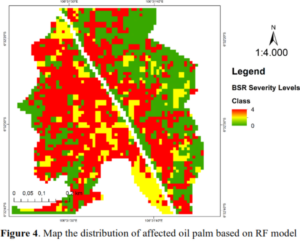 Author: R D Handrian, Bambang Hendro Trisasongko, and Dyah R Panuju
Author: R D Handrian, Bambang Hendro Trisasongko, and Dyah R Panuju
Abstract: Oil palm remains the most prominent plantation sector in Indonesia. Monitoring large scale plantations require specificity in datasets and approaches. Observing the extent of plantations has long been conducted using remotely-sensed data. With the complex issues in oil palm plantations, focus has also been made in investigating the utility of earth-observing satellites to estimate foliar nutrients and to identify the impact of plant diseases. The latter has been one of emerging research interests, especially the basal stem rot (BSR) caused by Ganoderma boninense. In this research, we proposed a freely-available, multispectral data of Sentinel-2 taking the advantage of frequent observation period. Preliminary discrimination of BSR impacts was examined by using a popular machine learning approach, i.e. random forests. Ground data as the reference were collected in Cikasungka plantation, Bogor, Indonesia. Using a tuned random forest model, we obtained overall accuracy about 82% with five distinctive targets, i.e. four severity levels and the normal trees. This research suggests that tuned random forest model could be invaluable for constructing a proper machine learning model that adaptive to data feeds.
Keywords: Basal stem rot; Ganoderma; Machine learning; Oil palm; Sentinel-2
Journal URL: https://iopscience.iop.org/article/10.1088/1755-1315/950/1/012043/meta
